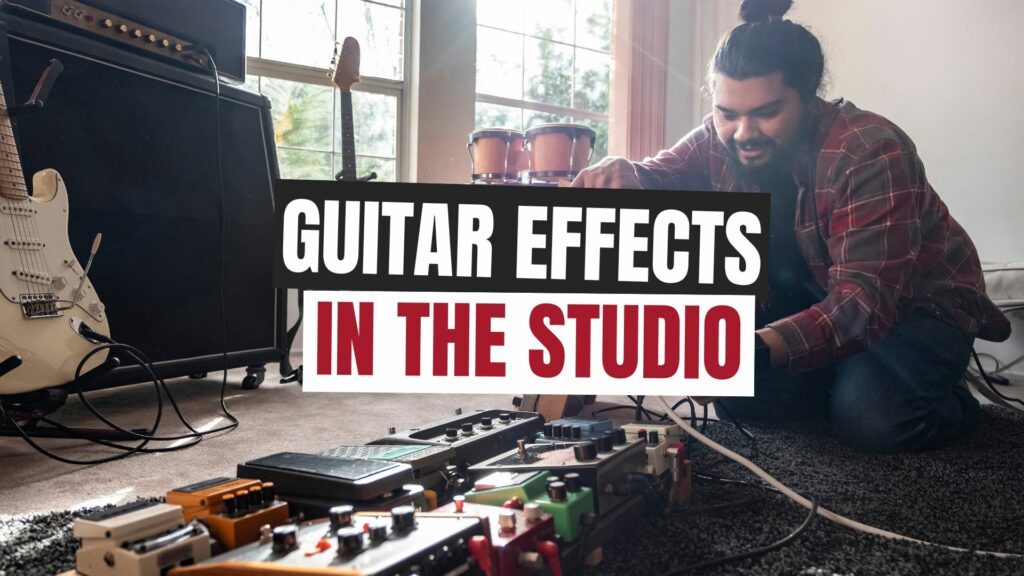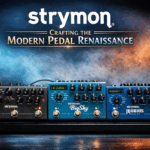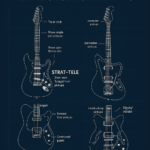Introduction:
In the realm of music production, the studio is the laboratory where innovation meets artistry. It’s here that musicians and producers harness the transformative power of technology to sculpt and shape their sonic visions. Among the essential tools in this creative arsenal, guitar effects pedals stand as enigmatic devices, capable of turning an ordinary guitar tone into a sonic masterpiece.
As we delve into the fascinating universe of guitar effects, we’ll explore the science behind these devices, examine their diverse categories, and discover how they can be wielded to elevate your guitar tones to new heights. From the timeless grit of distortion to the ethereal spaces created by reverb and delay, every effect pedal is a brushstroke on your musical canvas, allowing you to paint sonic landscapes that captivate listeners and fuel your creativity.
Whether you’re a rock virtuoso, an experimental artist pushing boundaries, or a songwriter searching for that elusive sonic identity, this blog will equip you with the knowledge and inspiration needed to utilize guitar effects as tools of sonic artistry. So, grab your favorite axe, stomp on that pedal, and let’s embark on a sonic adventure where creativity knows no bounds. Let the journey begin!
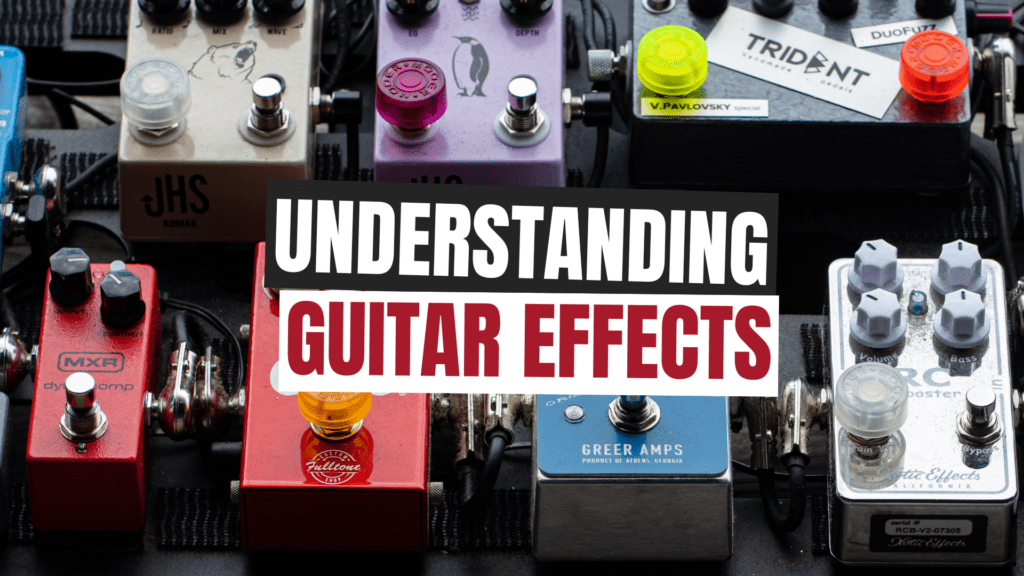
Section 1: Understanding Guitar Effects
To fully harness the creative potential of guitar effects in the studio, it’s essential to start with a solid understanding of what these devices are and how they function. Guitar effects, often referred to as “stompboxes” or simply “pedals,” are electronic devices designed to alter the sound of an electric guitar in various ways. They’re the secret sauce that can turn a straightforward guitar tone into a multi-dimensional sonic masterpiece. In this section, we’ll dive deeper into the fundamental aspects of guitar effects.
1.1 Types of Effects: Distortion, Modulation, Time-Based, and Dynamics Guitar effects can be categorized into several main types, each with its unique sonic characteristics and applications:
- Distortion: These effects, including overdrive, distortion, and fuzz, are known for adding grit, sustain, and harmonically rich textures to your guitar sound. They are staples in rock, metal, and blues music.
- Modulation: Modulation effects, such as chorus, flanger, and phaser, introduce dynamic changes to your guitar signal, creating a sense of movement and depth. They are often used to add a shimmering quality to clean tones or to make solos stand out.
- Time-Based Effects: This category includes reverb and delay. Time-based effects manipulate the timing of your guitar signal to create spaces, echoes, and ambience. They can make your guitar sound as if it’s in a vast cathedral or a small room.
- Dynamics: Dynamics effects like compressors and limiters help control the volume and dynamics of your guitar signal. They are used to smooth out peaks and valleys in your playing, ensuring a consistent and polished sound.
1.2 Analog vs. Digital Effects Guitar effects come in two primary formats: analog and digital. Each has its strengths and characteristics:
- Analog Effects: These are based on analog circuitry and are often favored for their warm and organic sound. They tend to color the tone and add a certain character to your guitar sound.
- Digital Effects: Digital effects use digital signal processing to recreate various sounds and effects. They offer precision, versatility, and the ability to replicate classic sounds accurately.
1.3 Signal Chain and Pedal Order Understanding the signal chain, or the order in which you connect your pedals, is crucial for achieving the desired guitar tone. The order in which you arrange your effects can significantly impact the final sound. Common signal chain orders include:
- Guitar → Tuner → Dynamics → Distortion/Overdrive → Modulation → Time-Based → Amp
However, there are no strict rules, and experimentation is encouraged to find your unique sound.
1.4 Controls and Parameters Each effects pedal comes with specific controls and parameters that allow you to fine-tune the effect to your liking. Common controls include knobs for adjusting parameters like level, tone, gain, depth, and rate. Understanding these controls is essential for shaping your sound effectively.
By grasping these fundamental concepts, you’ll be well-prepared to explore the vast world of guitar effects. In the following sections, we’ll delve deeper into each type of effect, discussing their creative applications, famous examples, and how to use them effectively in the studio to elevate your guitar tones. So, whether you’re seeking to add some fiery distortion or create lush, ambient textures, your journey into the world of guitar effects begins with a solid foundation of understanding.
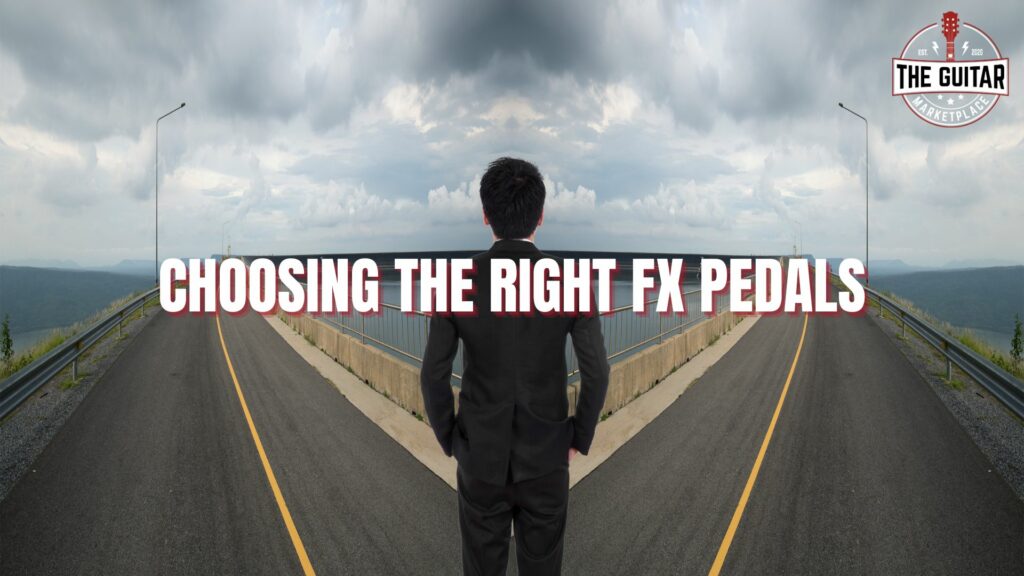
Section 2: Choosing the Right Effects Pedals
Selecting the perfect effects pedals for your guitar setup is like choosing colors for your musical canvas. Here’s a concise guide to help you make the right choices:
2.1 Consider Musical Style:
- Match pedals to your musical genre. Distortion for rock, chorus for pop, or ambient effects for experimental music.
2.2 Reflect Your Playing Style:
- Choose pedals that complement your playing style. Lead guitarists may need sustain-enhancing effects, while rhythm guitarists may prefer texture-adding pedals.
2.3 Set a Budget:
- Decide on your budget range and explore pedals that offer a balance of affordability and quality.
2.4 Size and Portability:
- Think about your pedalboard space. Compact pedals save space, while larger ones offer more control.
2.5 Analog vs. Digital:
- Consider whether you prefer the warmth of analog or the versatility of digital effects, or a mix of both.
2.6 Brand Reputation:
- Opt for trusted brands known for reliability and quality. Online reviews and recommendations can be valuable.
By considering these factors, you’ll be on your way to assembling a pedalboard that enhances your musical creativity and expression.

Section 3: Basic Effects and Their Uses
In this section, we’ll delve into the essential guitar effects and explore how each one can be creatively applied to shape your guitar’s tone and elevate your music. These effects are the building blocks of sonic experimentation and are found in many music genres.
3.1 Distortion, Overdrive, and Fuzz
- Distortion: This effect adds grit and sustain to your guitar tone, making it ideal for rock and metal. Explore settings to find your desired level of aggression.
- Overdrive: Overdrive pedals provide a smoother, warmer distortion often associated with blues and classic rock. Adjust gain and tone for nuances.
- Fuzz: Fuzz pedals create thick, saturated tones with fuzzy edges. They’re great for psychedelic and experimental music. Experiment with different fuzz flavors.
3.2 Chorus, Flanger, and Phaser
- Chorus: Chorus pedals add thickness and movement to your sound by modulating the pitch slightly. They’re perfect for creating lush, spacious tones in genres like pop and clean jazz.
- Flanger: Flangers produce sweeping, jet-like sounds. They’re excellent for adding dynamic movement to your guitar and are often used in rock and metal.
- Phaser: Phaser effects create a swirling, spacey sound. They’re versatile and work well in a variety of musical styles, from funk to prog rock.
3.3 Delay and Echo
- Delay: Delay pedals repeat your guitar signal, creating echoes. Adjust delay time and feedback for various effects, from subtle slapback to expansive ambiance.
- Echo: Echo pedals offer more pronounced and rhythmic repeats. They’re used in genres where precise timing and rhythm are crucial.
3.4 Reverb
- Reverb: Reverb pedals simulate the sound reflections in different spaces, from small rooms to grand halls. They add depth and space to your sound, making it more immersive. Tailor the decay and mix to match your desired ambiance.
3.5 Tremolo
- Tremolo: Tremolo pedals modulate the volume of your guitar signal in a rhythmic pattern. They’re ideal for creating pulsating and hypnotic effects. Adjust the speed and depth for various tremolo styles.
3.6 Wah-Wah
- Wah-Wah: Wah pedals are known for their expressive, vowel-like tones. Rock, funk, and blues guitarists often use them to add vocal-like inflections to their playing. Rock the pedal back and forth to control the wah effect.
These basic effects are the foundation of guitar sound manipulation. As you explore each one, you’ll discover how they can shape your guitar tone to suit various genres and moods. Whether you’re aiming for scorching distortion, ethereal echoes, or anything in between, these effects are essential tools in your sonic toolkit.

Section 4: Modulation Effects for Texture
Modulation effects are the wizards of the sonic realm, capable of transforming your guitar tone into a dynamic, evolving landscape. These effects introduce subtle or pronounced variations in your sound, creating movement, depth, and textural richness. In this section, we’ll delve into modulation effects and their versatile applications.
4.1 Chorus: Capturing Liquid Harmony
- Chorus pedals mimic the effect of multiple guitars playing simultaneously with slight pitch variations.
- Use chorus to add a sense of width and warmth to your clean tones, creating a lush, shimmering sound.
- Experiment with the rate and depth controls to achieve anything from gentle, watery ripples to more pronounced warbles.
4.2 Flanger: Jet-Setting through Time and Space
- Flanger effects produce a sweeping, jet-like sound by creating phase cancellation between two identical signals.
- Apply flanger to create dramatic, sweeping motions in your guitar tone, perfect for psychedelic and progressive rock.
- Adjust the feedback and depth knobs to control the intensity of the flanger effect.
4.3 Phaser: Swirling Cosmic Textures
- Phaser pedals generate a sweeping, swirling sound reminiscent of space-age sci-fi.
- Use phaser to add depth and dimension to your guitar sound. It’s versatile and works well across various musical genres.
- Experiment with the rate and resonance settings to create subtle or intense phase-shifting effects.
4.4 Vibrato: Shaping Vibrant Vibrations
- Vibrato effects modulate the pitch of your guitar signal, creating subtle variations in pitch and vibrato-like textures.
- Employ vibrato to add expressiveness to your playing, particularly for lead guitar solos.
- Adjust the depth and speed controls to tailor the vibrato effect to your preferences.
4.5 Leslie Speaker Simulator: The Rotary Revolution
- Leslie speaker simulators emulate the swirling, rotating speaker effect commonly heard in organs.
- Use this effect to add a distinctive, swirling motion to your guitar sound, especially in genres like blues and rock.
- Experiment with settings to capture the authentic Leslie speaker vibe, complete with speed and acceleration adjustments.
4.6 Ring Modulator: The Sonic Anomaly
- Ring modulators create dissonant and otherworldly sounds by modulating the amplitude and frequency of your guitar signal.
- Employ ring modulation for experimental, avant-garde, or sci-fi soundscapes.
- This effect is all about exploring extremes, so get creative with the knobs to produce unexpected sonic anomalies.
Modulation effects are your ticket to crafting dynamic soundscapes and textures that push the boundaries of conventional guitar tones. Whether you’re aiming for subtle, ethereal atmospheres or bold, experimental sound explorations, these effects are your allies in the quest for sonic innovation and expressiveness. Adjust, tweak, and let your imagination roam as you sculpt unique textures that elevate your music to new heights.

Section 5: Time-Based Effects and Ambiance
Time-based effects transport your guitar sound through the dimension of time, creating lush soundscapes, dreamy echoes, and immersive atmospheres. In this section, we’ll dive into the enchanting world of time-based effects, exploring how they can add depth and ambiance to your guitar tones.
5.1 Delay: Echoes of the Past and Future
- Delay pedals capture your guitar signal and repeat it, creating echoes that can be short and rhythmic or long and spacious.
- Use delay to add a sense of space and depth to your guitar sound, from slapback for rockabilly to ethereal ambience for post-rock.
- Experiment with delay time, feedback, and mix controls to craft the perfect delay effect for your music.
5.2 Reverb: The Breath of Sonic Environments
- Reverb pedals simulate the sonic reflections in various spaces, from intimate rooms to vast cathedrals.
- Apply reverb to infuse your guitar sound with ambiance and depth, enhancing the sense of space in your music.
- Adjust decay time, size, and mix to create the desired reverberation, from subtle room tone to epic, cathedral-like reverbs.
5.3 Echo: Time-Traveling Sound Waves
- Echo pedals offer pronounced, rhythmic repeats of your guitar signal, creating a distinct sense of time and rhythm.
- Use echo to add rhythmic patterns and rhythmic accents to your guitar lines, ideal for genres like rockabilly and reggae.
- Tailor echo time, feedback, and mix controls for rhythmic precision and musicality.
5.4 Ambient Reverb and Delay: Expansive Soundscapes
- Combining reverb and delay can transport your guitar into expansive sonic realms, ideal for genres like post-rock and ambient music.
- Experiment with intricate delay patterns and extended reverb tails to create vast, evolving soundscapes.
- These effects are perfect for building atmospheric sound textures and evolving musical landscapes.
5.5 Multi-Mode Effects: Versatile Ambiance Creators
- Some pedals offer multiple time-based effects in one unit, allowing you to experiment with various delay and reverb textures.
- Multi-mode effects are versatile tools for creating dynamic and diverse sonic landscapes across different musical styles.
- Dive into presets and explore various combinations of delay and reverb to discover new ambient possibilities.
Time-based effects are your artistic paintbrushes for creating depth and ambiance in your music. Whether you seek the nostalgic charm of vintage echoes, the immersive qualities of reverb, or the limitless possibilities of ambient soundscapes, these effects offer you the means to craft intricate, evocative soundscapes that captivate listeners and elevate your music to new heights. Adjust the controls, experiment with different textures, and let your sonic imagination soar.

Section 6: Creative Soundscaping with Ambient Effects
Ambient effects open the door to sonic experimentation, allowing you to craft ethereal and immersive soundscapes that transport listeners to otherworldly realms. In this section, we’ll explore how to use ambient effects to create captivating and evocative sonic textures.
6.1 Tremolo: Pulsating Ambiance
- Tremolo effects modulate the volume of your guitar signal, producing rhythmic pulses.
- Use tremolo to add pulsating textures that evoke the feeling of waves crashing, heartbeats, or distant machinery.
- Experiment with different tremolo shapes (sine, square, triangle) and adjust the rate and depth for varying rhythmic patterns.
6.2 Pitch Shifters: Shaping Sonic Dimensions
- Pitch shifters alter the pitch of your guitar signal, creating harmonies, octaves, and otherworldly sounds.
- Apply pitch shifters to create dreamy, surreal textures and harmonize with yourself.
- Experiment with intervals and settings to produce unique harmonic landscapes.
6.3 Freeze Pedals: Capturing Sonic Moments
- Freeze pedals allow you to capture and sustain a specific sonic moment, creating infinite sustain or drones.
- Use freeze pedals to build ambient layers, holding sustained notes or chords as you continue to play.
- Experiment with layering different freeze moments to create evolving soundscapes.
6.4 Modulated Reverb and Delay: Shifting Realities
- Modulated reverb and delay combine time-based effects with modulation, adding movement to your ambient textures.
- Apply these effects to create swirling, evolving soundscapes that shift and transform over time.
- Experiment with modulation parameters to control the depth and speed of the modulation.
6.5 Loopers: Building Sonic Canvases
- Loopers allow you to record and layer guitar phrases, creating intricate and evolving sonic canvases.
- Use loopers to craft ambient soundscapes by layering harmonies, melodies, and textures.
- Experiment with overdubs and the length of your loops to build complexity.
6.6 Synth and Granular Effects: Cosmic Textures
- Synth and granular effects transform your guitar into otherworldly instruments, generating abstract and cosmic textures.
- Apply these effects to create spacey, atmospheric soundscapes that transport listeners to uncharted realms.
- Experiment with various synth and granular settings to find unique textures and tones.
Ambient effects offer endless creative possibilities, allowing you to paint sonic landscapes that resonate with emotions and imagery. Whether you’re seeking to evoke the vastness of space, the depths of the ocean, or the serenity of a dream, these effects empower you to craft ambient textures that captivate, inspire, and transcend traditional musical boundaries. Embrace experimentation, let your imagination roam freely, and explore the uncharted sonic territories that ambient effects offer.

Conclusion:
In the realm of guitar effects, creativity knows no bounds, and the possibilities are as limitless as the depths of your imagination. Throughout this exploration of various effects, we’ve journeyed from the realm of distortion’s gritty rebellion to the ethereal expanses of ambient soundscapes. Guitar effects are the tools that transform your guitar into a portal to sonic worlds that captivate, inspire, and move audiences.
As you embark on your sonic adventures, remember that the true magic lies in your ability to harness these effects to convey emotions, tell stories, and connect with listeners on a profound level. Whether you’re a seasoned musician or just beginning your sonic journey, the knowledge gained from this guide equips you with the keys to unlock new dimensions of creativity.
Experimentation is your ally, and your guitar effects pedals are your companions on this artistic voyage. Each knob turn, pedal stomp, and note played represents a chance to express your unique musical voice and explore uncharted sonic territories. Whether you’re crafting timeless rock anthems, weaving intricate ambient tapestries, or venturing into uncharted musical genres, the world of guitar effects is yours to shape and mold.
In the words of legendary guitarist Jimi Hendrix, “Knowledge speaks, but wisdom listens.” As you delve into the world of guitar effects, listen to your instincts, embrace your creativity, and let your music speak with the voice you’ve cultivated. Whether you’re chasing the timeless tones of rock gods or forging new paths in musical innovation, the canvas is yours, and the effects are your palette.
So, stomp those pedals, twist those knobs, and soar on the wings of sonic exploration. Let your guitar effects be the conduits through which your musical visions become reality. May your journey through the world of guitar effects be a never-ending source of inspiration, innovation, and sonic magic. The stage is set, and the spotlight is yours. Now, let your music shine!
-
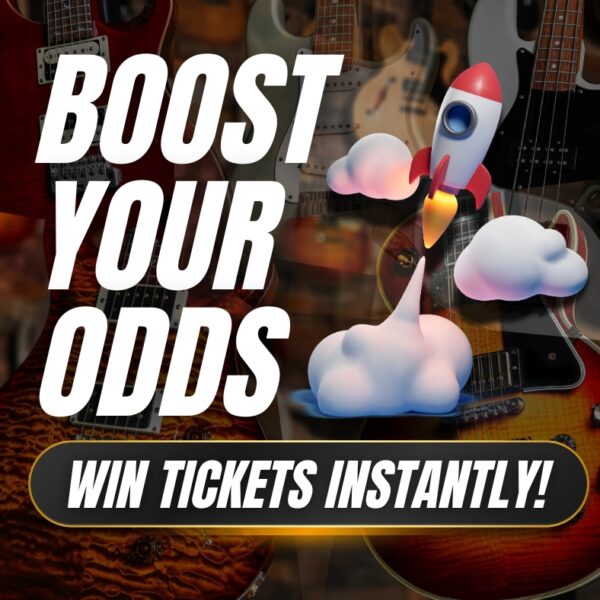 Boost Your Odds – Win Tickets Instantly!£1.99Per Entry
Boost Your Odds – Win Tickets Instantly!£1.99Per Entry -
 Taylor GS Mini-e Special Edition Electro-Acoustic in Silverburst£0.99Per Entry
Taylor GS Mini-e Special Edition Electro-Acoustic in Silverburst£0.99Per Entry -
 Jackson SL7Q Pro Soloist in Alien Burst Green£2.99Per Entry
Jackson SL7Q Pro Soloist in Alien Burst Green£2.99Per Entry -
 Taylor 814ce Grand Auditorium£3.99Per Entry
Taylor 814ce Grand Auditorium£3.99Per Entry -
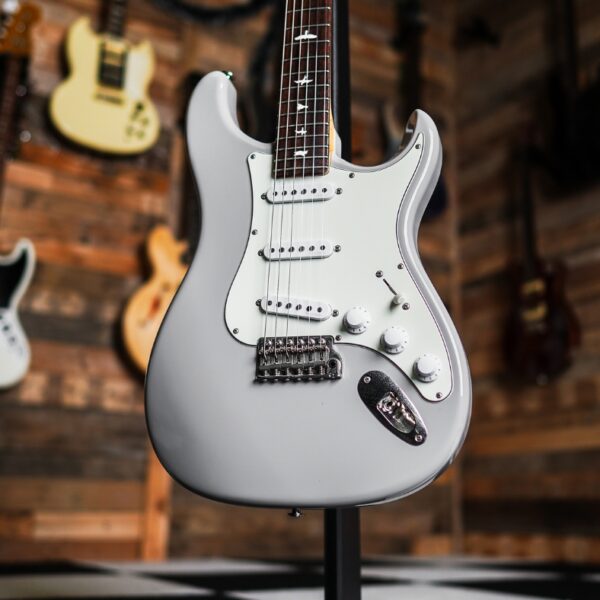 PRS USA John Mayer Silver Sky Silver in Tungsten£0.30Per Entry
PRS USA John Mayer Silver Sky Silver in Tungsten£0.30Per Entry -
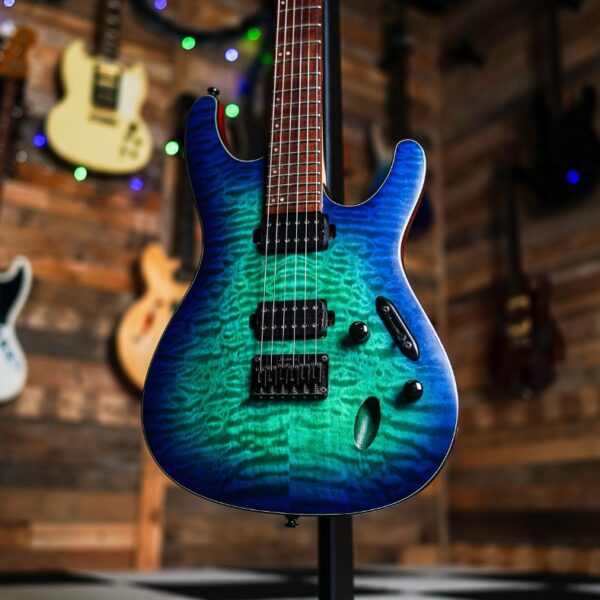 Ibanez S621QM in Saphire Blue Flat£0.07Per Entry
Ibanez S621QM in Saphire Blue Flat£0.07Per Entry -
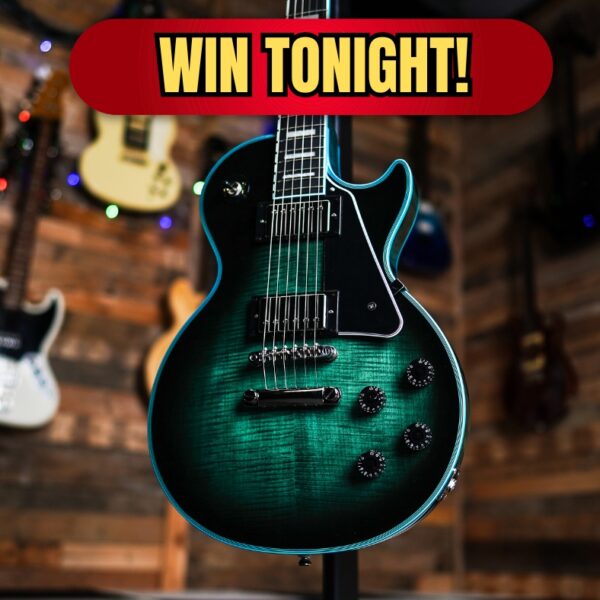 Epiphone Limited Edition Les Paul Custom Widow In Indigo Burst£0.99Per Entry
Epiphone Limited Edition Les Paul Custom Widow In Indigo Burst£0.99Per Entry -
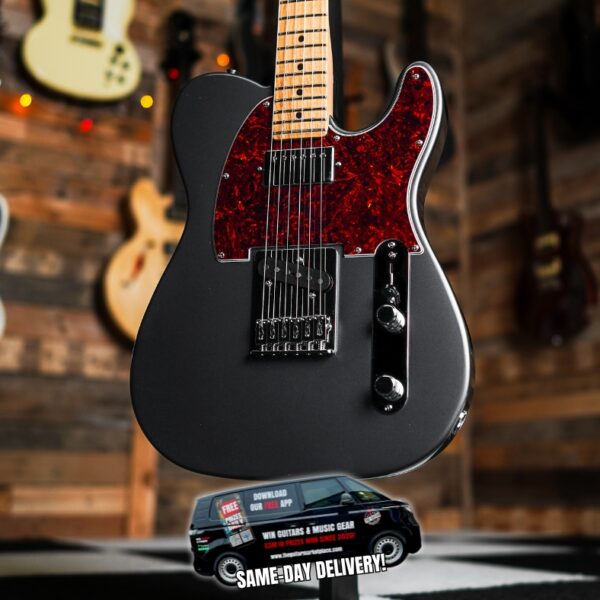 Fender guitarguitar Exclusive Player II Telecaster Roasted Maple Fingerboard in Charcoal Frost Metallic! Same-Day Delivery in the TGM Bus£1.25Per Entry
Fender guitarguitar Exclusive Player II Telecaster Roasted Maple Fingerboard in Charcoal Frost Metallic! Same-Day Delivery in the TGM Bus£1.25Per Entry -
 Free Wild Wednesday Giveaway! Spend £0 & Win a Mooer PRIMES1 Multi-FX or Spend £5+ & Win a Line 6 Pod Go Multi-FX£0.00Per Entry
Free Wild Wednesday Giveaway! Spend £0 & Win a Mooer PRIMES1 Multi-FX or Spend £5+ & Win a Line 6 Pod Go Multi-FX£0.00Per Entry

